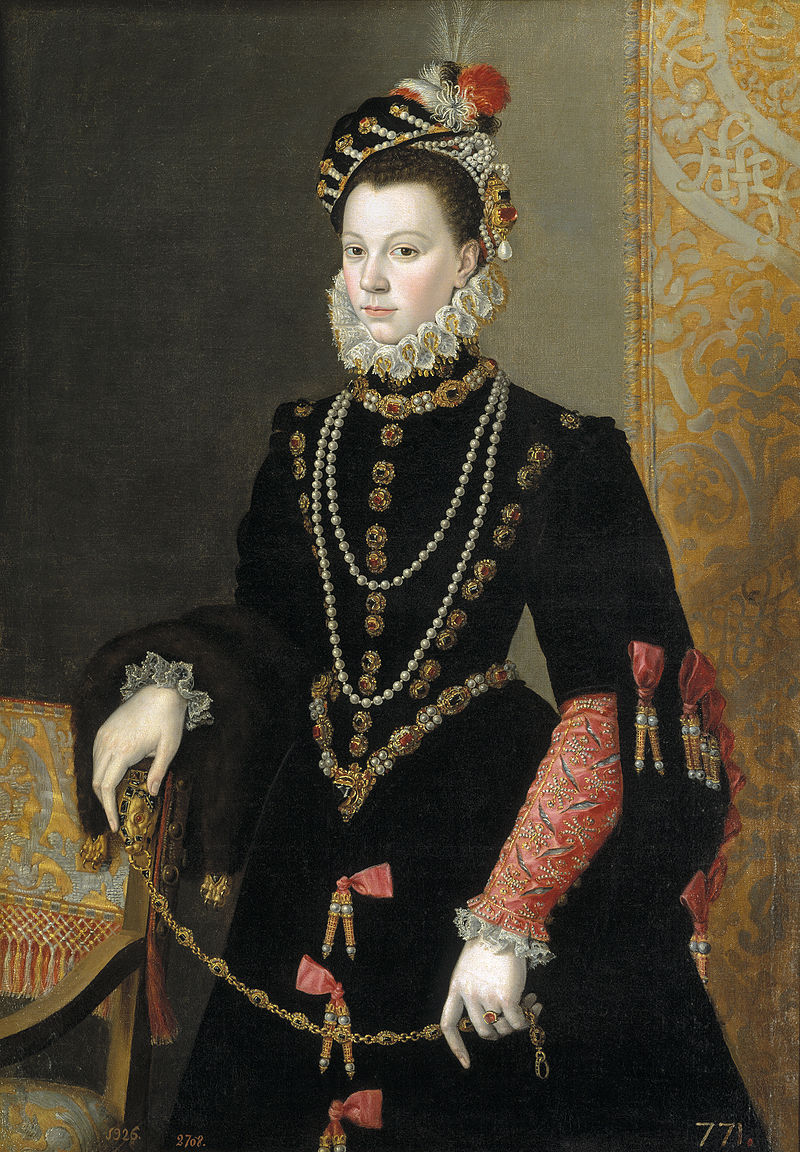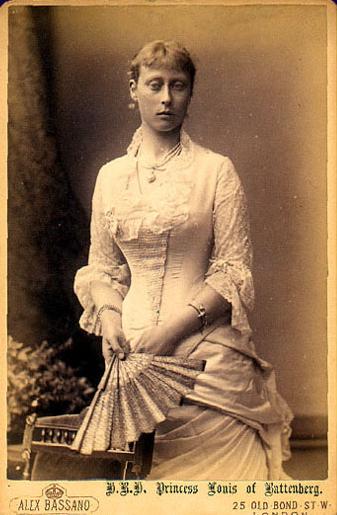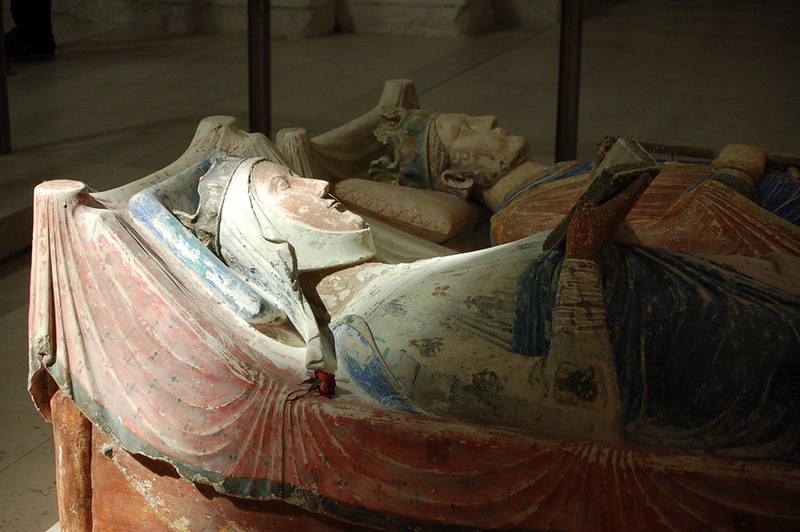© Unofficial Royalty 2025

Élisabeth de Valois, Queen of Spain; Credit – Wikipedia
April 2, 1272 – Death of Richard, Earl of Cornwall, son of King John of England, at Berkhamsted Castle in Hertfordshire, England; buried at Hailes Abbey in Winchcombe, Gloucestershire, England
In 1231, Richard married 30-year-old, widowed Isabel Marshal, daughter of William Marshal, 1st Earl of Pembroke, who had served three kings: Henry II, Richard I, and John, and had been the protector of Richard’s brother King Henry III, and regent of the kingdom. Isabel died while delivering her fourth child, who also died. In 1243, Richard married Sanchia of Provence, the sister of Eleanor of Provence, the wife of his brother King Henry III. The couple had two children, and Sanchia died in 1261. The displeasure of the English nobility with King Henry III ultimately resulted in a civil war, the Second Barons’ War (1264–1267). The leader of the forces against Henry was his brother-in-law, Simon de Montfort, 6th Earl of Leicester, who was married to Henry’s sister Eleanor. Richard was a supporter of his brother during the Second Barons’ War. He was taken prisoner at the Battle of Lewes and imprisoned until his nephew, the future King Edward I, led the royalists into battle again, defeating and killing de Montfort at the Battle of Evesham in 1265. 60-year-old Richard made a third marriage to 15-year-old Beatrice of Falkenburg in1269. In 1271, Richard had a stroke that paralyzed his right side and caused him to lose the ability to speak. He died one year later at the age of 63.
Unofficial Royalty: Richard, Earl of Cornwall
April 2, 1502 – Death of Arthur, Prince of Wales, son of King Henry VII of England, at Ludlow Castle in Shropshire, England; buried at Worcester Cathedral in Worcester, England
For the first child of King Henry VII of England, the first Tudor monarch, the name Arthur was chosen in hopes that he would bring a new Arthurian age to the new Tudor dynasty. Sadly, that was not to be. Within months of their marriage, Arthur and Catherine of Aragon became ill, probably of the sweating sickness. Catherine survived, but she was left a widow as Arthur did not survive. Henry VII and his wife, Elizabeth of York, were naturally distraught at the death of their eldest son. Their second son succeeded his father as King Henry VIII in 1509, leaving us to ask the question, “What if Arthur had become king?”
Unofficial Royalty: Arthur, Prince of Wales
April 2, 1545 – Birth of Élisabeth de Valois, Queen of Spain, third of the four wives of King Felipe II of Spain, at Château de Fontainebleau in France
Elisabeth was the daughter of Henri II, King of France and Catherine de’Medici. 14-year-old Elisabeth married 32-year-old King Philip II of Spain. Philip had already been married twice and needed a male heir. Elisabeth considered her main duty to give birth to sons but she was unable to do so. She had five pregnancies but had only two surviving daughters. Elisabeth died after giving birth to a premature daughter who also died.
Unofficial Royalty: Élisabeth de Valois, Queen of Spain
April 2, 1653 – Birth of Prince George (Jørgen) of Denmark, husband of Queen Anne of Great Britain and son of King Frederik III of Denmark and Norway, at Copenhagen Castle in Copenhagen, Denmark
In 1683, George married the future Queen Anne of Great Britain. Sadly, George and Anne had issues with providing an heir. Anne had 17 pregnancies with only five children being born alive. Two died on the day of their birth, two died at less than two years old, within six days of each other from smallpox, and one died at age 11. George played no part in politics and had no real ambitions. His uncle by marriage, King Charles II, famously said of George, “I have tried him drunk, and I have tried him sober, and drunk or sober, there is nothing there.” In the spring of 1706, George became seriously ill but seemed to recover. He spent much of the summer of 1708 at Windsor Castle with asthma that was so bad he was not expected to live. He died on October 28, 1708, at the age of 55.
Unofficial Royalty: Prince George of Denmark
April 2, 1657 – Death of Ferdinand III, Holy Roman Emperor in Vienna, Archduchy of Austria, now in Austria; buried in the Imperial Crypt at the Capuchin Church in Vienna
Ferdinand III, Holy Roman Emperor, was also Archduke of Lower and Inner Austria (reigned 1637 – 1657), King of Bohemia (reigned 1627 – 1657), and King of Hungary and Croatia (reigned 1625 – 1657). Ferdinand III became Holy Roman Emperor in 1537, during the last decade of the Thirty Years’ War (1618 – 1648). The Thirty Years’ War was one of the longest and most destructive conflicts in European history, with an estimated 4.5 to 8 million soldiers and civilians dying as a result of battle, famine, and disease. Although he knew the Holy Roman Empire would be weaker, Ferdinand set out on a policy toward ending the war. The Peace of Westphalia, signed in October 1648, ended the Thirty Years’ War and brought peace to the Holy Roman Empire. Holy Roman Emperor Ferdinand III, the kingdoms of France and Sweden, and their allies among the constituent states of the Holy Roman Empire participated in the treaties.
Unofficial Royalty: Ferdinand III, Holy Roman Emperor, Archduke of Lower and Inner Austria, King of Bohemia, King of Hungary and Croatia
April 2, 1826 – Birth of Georg II, Duke of Saxe-Meiningen in Meiningen, Duchy of Saxe-Meiningen, now in Thuringia, Germany
Georg II was Duke of Saxe-Meiningen from 1866 until he died in 1914. In 1850, Georg married Princess Charlotte of Prussia. The couple had four children, but Charlotte died in March 1855, just after giving birth to their fourth child, who also died. In 1858, Georg married Princess Feodora of Hohenlohe-Langenburg, the daughter of Ernst I, Prince of Hohenlohe-Langenburg and Princess Feodora of Leiningen, the elder half-sister of Queen Victoria of the United Kingdom. They had three children. Georg was passionate about the theatre and established the Meiningen Theater. The company toured extensively throughout Germany and Europe from 1874 to 1890. Georg was also the patron of the Meiningen Court Orchestra. Under his patronage, the orchestra became prominent in the 1880s when Georg hired Hans von Bülow as its conductor. The orchestra served as an ensemble for Johannes Brahms, who even conducted himself when premiering his Fourth Symphony. Brahms remained connected to the orchestra for the rest of his life.
Unofficial Royalty: Georg II, Duke of Saxe-Meiningen
April 2, 1829 – Death of Friedrich VI, Landgrave of Hesse-Homburg, husband of Princess Elizabeth of the United Kingdom, in Bad Homburg in the Landgraviate of Hesse-Homburg, now in Hesse, Germany; buried in the Mausoleum of the Landgraves in Homburg
Friedrich married Princess Elizabeth of the United Kingdom, one of the three out of the six daughters of King George III who managed to get married. Both Elizabeth and Friedrich were 48 years old when they married. The marriage was not a love match, but through mutual understanding and respect, it was a happy marriage that met the needs of both Elizabeth and Friedrich. When Friedrich died due to influenza and complications from an old leg wound, Elizabeth wrote, “No woman was ever more happy than I was for eleven years and they will often be lived over again in the memory of the heart.”
Unofficial Royalty: Friedrich VI, Landgrave of Hesse-Homburg
April 2, 1867 – Death of Emilie of Schwarzburg-Sondershausen, wife of Leopold II, Prince of Lippe, in Detmold, then in the Principality of Lippe, now in the German state of North Rhine-Westphalia; buried in the Mausoleum on the Büchenberg in Detmold
Princess Emilie of Schwarzburg-Sondershausen was the wife of Leopold II, Prince of Lippe. Emilie and Leopold had nine children, including three reigning Princes of Lippe, but none of their children had children. Leopold II had a passion for the theater, and with the help of his wife Emilie, the Lippe Princely Court Theater was established in Detmold in 1825. The theater established by Leopold II and Emilie is still in existence today. Now called the Landestheater Detmold, it is a theater for operas, operettas, musicals, ballets, and stage plays in Detmold, North Rhine-Westphalia, Germany.
Unofficial Royalty: Emilie of Schwarzburg-Sondershausen, Princess of Lippe
April 2, 1949 – Death of Louisa McDonnell, Countess of Antrim, Queen Victoria’s Acting Mistress of the Robes 1894, Lady of the Bedchamber 1890–1901, and Queen Alexandra’s Lady of the Bedchamber 1901-1910; in London, England; buried in the Antrim family graveyard at Glenarm Castle in Glenarm, Northern Ireland
Born Louisa Jane Grey, she was the daughter of The Honorable Charles Grey, who served as the Private Secretary to Prince Albert from 1849 until the Prince died in 1861 and then as Private Secretary to Queen Victoria until his own death in 1870. She married William McDonnell, 6th Earl of Antrim.
Unofficial Royalty: Louisa McDonnell, Countess of Antrim
April 2, 1955 – Birth of Princess Sirindhorn of Thailand, daughter of King Bhumibol Adulyadej of Thailand, at the Amphorn Sathan Residential Hall, Dusit Palace in Bangkok, Thailand
Princess Sirindhorn attended Chulalongkorn University, earning a bachelor’s degree in history in 1976. After that, she enrolled in two Master’s programs concurrently, earning a master’s degree in Oriental Epigraphy in 1979 from Silpakorn University, and another in Oriental Languages from Chulalongkorn University in 1980. She later received a doctorate in Educational Development in 1986 from Srinakharinwirot University. The Princess is a professor and Head of the History Department at the Chulachomklao Royal Military Academy, in addition to many royal duties and visits on behalf of her brother King Maha Vajiralongkorn.
Unofficial Royalty: Princess Sirindhorn of Thailand
This article is the intellectual property of Unofficial Royalty and is NOT TO BE COPIED, EDITED, OR POSTED IN ANY FORM ON ANOTHER WEBSITE under any circumstances. It is permissible to use a link that directs to Unofficial Royalty.










